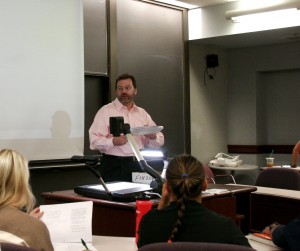In an exclusive speech to UR faculty on Monday, Sept. 26, President Joel Seligman gave a lengthy presentation touting UR’s achievements in everything from finances to dining and revealed his plans to formally launch “the public phase of the largest capital campaign” in UR’s history on Oct. 21.
By 2016, the “transformative campaign” will, among other anticipated improvements, place UR among the leading 20 research universities in the U.S., grow UR’s student body to approximately 10,000 students, further improve residential life, add roughly $1 billion in new facilities, expand performing arts programs, jump start research at the Medical Center and improve faculty, Seligman said.
Despite economic malaise, Seligman stressed UR’s resilience — notably how the University has had its largest year-to-year increase in the size of its faculty this year, welcoming 20 new professors. UR currently stands as the sixth largest private employer in New York state.
“This year, the College reached a key revised strategic goal with a total of 350 tenured and tenure-track faculty but will continue to grow as gifts for endowed professorships provide resources for additional new faculty,” Seligman said.
Even as the number of students has grown, the size of the average class section has decreased as a result of these changes, according to Senior Vice President and Dean of the College Faculty Peter Lennie.
Two endowed professorship gifts have supported faculty additions in the past year, Lennie said.
“These are very important to us, both in recognizing the distinction of the faculty who are here now and in enabling us to attract the most exceptional new faculty to join us,” he said.
In the last five years, during which net faculty grew by 25, UR added 12 new majors and 14 new minors, according to Lennie, who said he anticipates that UR will strengthen and enlarge the range of programs available to our students.”
Seligman also said that UR has been “particularly sensitive to tuition increases.”
The rate of tuition increase was reduced from 8.1 percent in 2006 to 4 percent for the 2011-2012 academic year, which Seligman said will “allow us to continue to provide outstanding programs for our students but reflects the belt tightening that has occurred across campus.”
Associate Vice President for Budgets and Planning Holly Crawford said that UR has taken several steps to decrease expenses, including deferring major capital projects and freezing salaries for all but the lowest paid employees during the 2010 fiscal year.
Crawford could not give estimates for tuition increases in the 2012-2013 academic year, but said that UR is “concerned about the impact of tuition increases on students and their families, and will continue to seek ways to moderate the rate of tuition growth,” which UR has accomplished through endowed professorships and financial aid scholarships.
Crawford also noted that UR is trying to keep the endowment spending below 6 percent in an effort to approach the goal of 5.5 percent per fiscal year. UR has worked “very hard” to decrease reliance on endowment spending and tuition rate increases by bolstering other sources of revenue including fundraising, research and enrollment growth, she said.
As families and universities nationwide continue to tighten budgets, Seligman retains an unwavering optimism for his ambitious so-called “Quest for Meliora.”
“Thanks to an incredibly dedicated senior leadership team, an amazingly talented faculty and staff, outstanding students and passionate and loyal alumni, our comprehensive capital campaign is likely to succeed,” he said.
Buletti is a member of the class of 2013.







